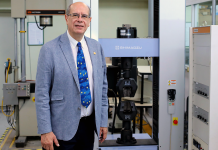
Your company, Orton, offers TempTabs, some pretty ingenious technology for monitoring temperature throughout a furnace. How did the idea come about?
Our founder, Edward Orton started a company to help monitor process temperatures in the ceramics industry. At that time, ceramic manufacturers would put ceramic pieces into kilns, and they were getting about a 50% yield. Some things were “over-fired.” Some things were “under-fired.” Edward Orton developed a series of specially formulated sensors to place alongside the ceramic in the kiln. These ceramic devices allowed the kiln operator to visually confirm the ceramic ware had seen the right amount of heatwork (temperature and time-at temperature) in the kiln. So they knew when it was time to remove the ware. This increased their yield and became a standard in the industry and continues to be used worldwide to monitor ceramic processes.
We took this same technology using specially blended ceramics to monitor process temperatures and adapted it to the needs of the metals industry, called TempTAB. TempTABs can be used in batch or continuous furnaces, work in various atmospheres including nitrogen/hydrogen/argon/air and vacuum. They have been pretreated so there is no outgassing and can even survive a nitrogen or oil quench. They were designed for use in heat treating, powder metal sintering and brazing operations.
If you don’t mind me saying, they look a little strange! For starters, they’ve got a hole in the middle.
There’s a reason for that. In some environments, there’s high velocity movement inside the furnace and they need to be secured in place. They can be tied to a part, or tied down to a basket. That way you can keep track of them.
Give our readers a crash course in the TempTab.
TempTABs are placed inside the furnace where the metal is being treated. They are measured with a micrometer once they exit the process. The size of the TempTAB is then used to determine the “TempTAB temperature” using the lookup table or software provided with each batch.
These sound like some pretty good insurance.
Furnaces tend to get picked on when there are production problems. These TempTabs allow you to defend your furnace. If you run these on a regular basis and you have the information from the temptabs, then when a problem comes up, you can say, “Nothing has changed in the thermal process.”
Are there other uses for TempTABs?
Temp TABs are an excellent aid to help you replicate processes. A lot of people will set up a process and then want to duplicate it. If you are using TempTABs in one furnace on a regular basis, you can set up the new process and run it until the TempTABs are reporting the same temperatures, you then can be sure that the process is fine-tuned—what’s going on inside both furnaces is the same.
They are an excellent monitoring device to confirm your thermal process. Placing one TempTAB in the center of the furnace every heat can confirm that the center of the furnace reaches the same time and temperature profile.
One of the best uses for TempTABs in a batch heat treat furnace is to use them to monitor your thermal process between formal surveys. If you run them along with your formal TUS by placing one TempTab near the end of each thermocouple, you have a benchmark of your TempTAB temperatures. You can continue to run TempTABs in those same nine locations as often as you like, to see if something changes in your furnace before your next formal TUS is scheduled—they act as sort of an “early warning device.”
Some heat treaters and continuous brazing operations will run them in an empty furnace as an easy way to make sure the uniformity is what they expect. If they find there’s a cold spot, they’ll try to figure out what’s going on—maybe they have an element out—and they’ll adjust and run it again until the uniformity shows that their furnace is operating the way it should.
What advantage do these have over thermocouples?
Thermocouples are very important to the thermal processing industry. They measure temperature at one point in the furnace, sometimes in the very top of the furnace, not necessarily where the parts are being processed. Temptabs can be placed throughout the load and can monitor temperatures in the load without interrupting production. Thermocouple also sometimes change over time. TempTabs help by alerting you if subtle changes take place like your thermocouples begin to drift or you electronic controller is in need of calibration. TempTABs do not change over time.
Quality and Process Verification
Letting your customers know (both internal and external) that you not only follow all the requirements of the industry but you also monitor your thermal process on a daily basis with TempTABs is proving good for business. We would welcome the opportunity to share how TempTABs can help your business.


























